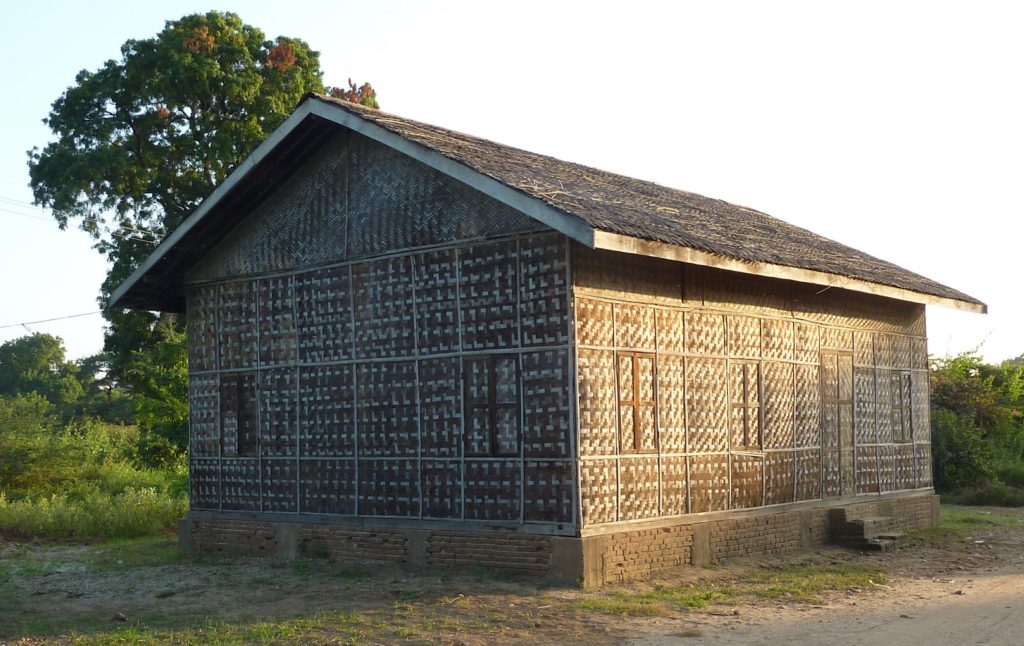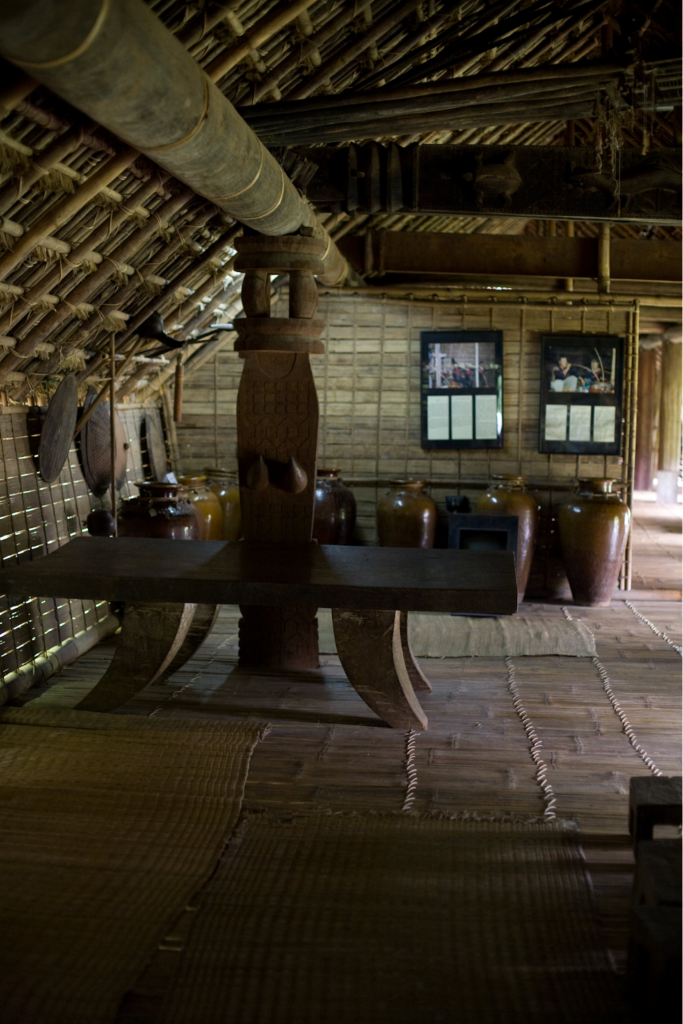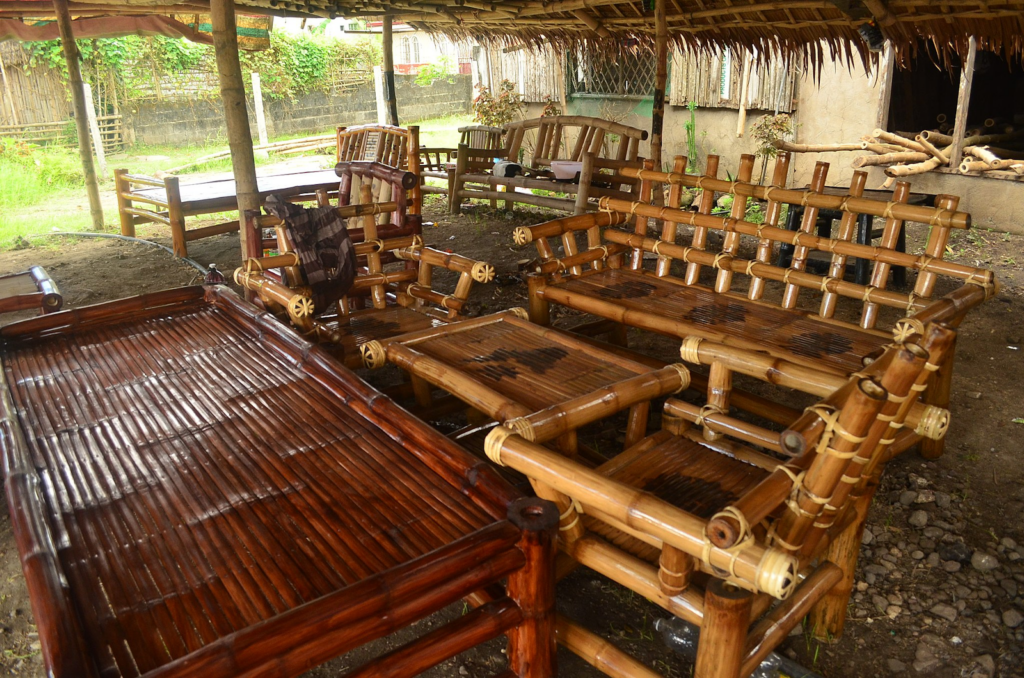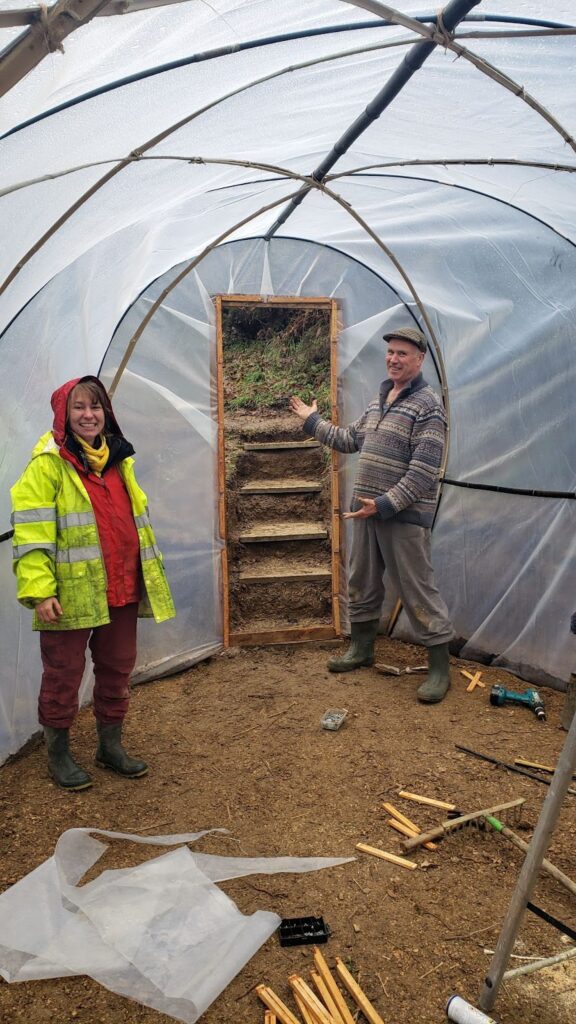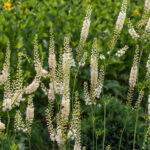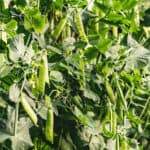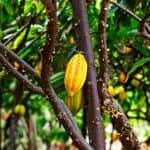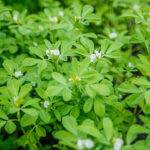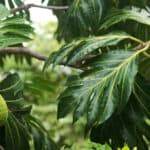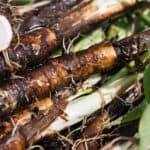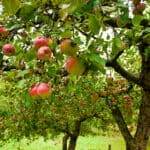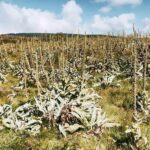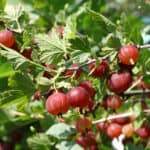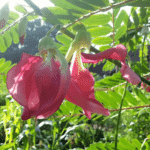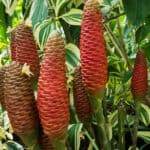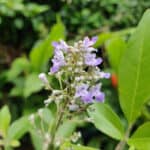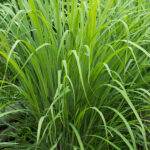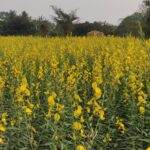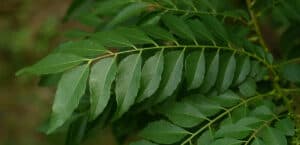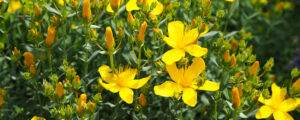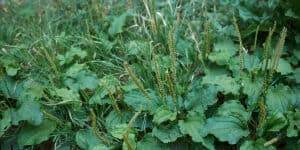From construction to carpentry and everyday crafts, no plant provides a more versatile resource than the many varieties of bamboo. With its strength, flexibility, and easy to work with character, Bamboo offers an excellent construction material for almost anything you can imagine. Not to mention, Bamboo grows quickly and readily renews itself after harvesting. After all, certain varieties of Bamboo are considered the world’s fastest-growing plants!
Even if you don’t plan to build a house with Bamboo, having at least one variety around for small things like trellises or stakes is a blessing. Not to mention, the atmosphere provided by Bamboo can easily transform a space into something spectacular. Also, did I mention many species have delicious edible shoots?
While the cultivation and use of Bamboo is an extensive topic that can fill textbooks with information, in this guide we will be discussing the most important things you should know when it comes to the cultivation of Bamboo.

Natural History of Bamboo
Bamboos are members of the grass family and make up the subfamily Bambusoideae. This sub-family contains over 1000 species in over 100 different genera! While they are most known for this use in various parts of Asia, different species of Bamboo occur naturally in various parts of the world, including in Latin America, Africa, Australia, and even parts of the United States. While there is a stunning diversity of bamboo, only about 100 species are cultivated for materials or food.
Note that there are many “bamboo-like” members of the plant family, often referred to as canes, that are not technically bamboo. While they have a plethora of uses, they are not generally as strong as bamboo. The most prolific and widely dispersed example of this is Arundo donax, also known as Giant Reed.
Types of Bamboo
Running Bamboos and Clumping Bamboos
While bamboo can be classified in many different ways, they are typically classified into two types based on their growth habits. These are Running Bamboos and Clumping Bamboos.
- Running Bamboos: These spread underground via rhizomes, allowing the plant to spread and grow into new areas. While running Bamboo can be good under some circumstances, the fact that it is difficult to contain can be problematic.
- Clumping Bamboos: These varieties stick to their clump, which can grow to tremendous sizes, but it only spreads as the clump slowly grows in diameter. These are much easier to contain and are the most recommended for this reason.
Heavy and Light Duty Construction Bamboo
Bamboo can also be classified into two categories based on their strength, flexibility, and applicability to construction.
- Heavy-duty Duty Bamboos: These are characterized by their robustness and strength. They typically have thicker walls and larger diameters, which contribute to their higher load-bearing capacity. Heavy-duty bamboos are more suitable for applications that require greater structural support and durability. This includes beams, columns, flooring, and other structural framework.
You should consider that growing heavy-duty bamboo for construction entails a relatively heavy investment in space, labor, and even equipment.- Managing, harvesting, and transporting this bamboo is heavy labor. A single cane of giant bamboo can weigh almost half a ton! It can also be dangerous if you are not prepared for the job.
- These not only need space to grow, but you also need space to let the canes dry and be treated. For these reasons, it is mostly recommended for folks who have ample room, large properties, and dedication.
- For permanent structures, treatment in some form is recommended. This can be done in many different ways with varying results, but it will require some labor and possibly specialized equipment.
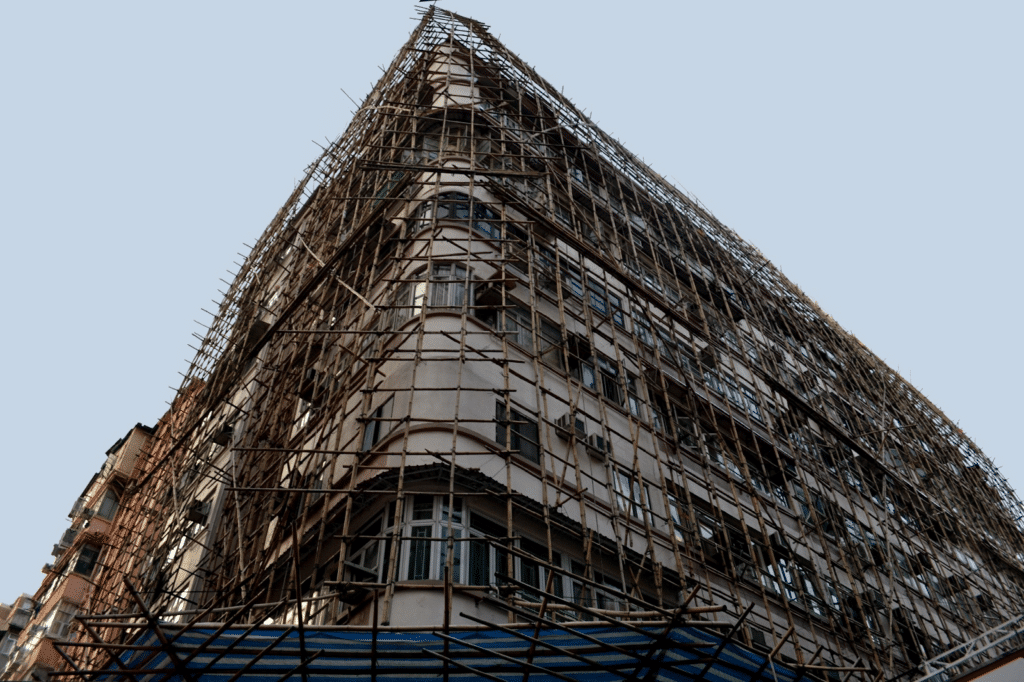
- Light-duty bamboo: These have thinner walls and smaller diameters compared to their heavy-duty counterparts. While they are more delicate, they can still be durable for specific applications. Light-duty bamboos are more suitable for non-load-bearing, temporary structures, and decorative purposes. They can be used for wall cladding, ceiling panels, furniture, and other handicrafts.
The Top Bamboos For Construction
Generally speaking, the two most important types of Bamboo for construction are those in the genera Guadua and Dendrocalamus. The species Guadua angustifolia and Dendrocalmus asper are considered the strongest and most versatile construction bamboo in the world. For temperate climates, species in the genus Phyllostachys (such as P. bambusoides) tend to have the best versatility and strength.
If you have ample room, it is not a bad idea to grow several types of bamboo. A larger heavy-duty one for construction, some small-diameter bamboo for crafts (ideally some with tasty shoots like Phyllostachys rubromarginata), and some in between for everything else.
Types Of Bamboo by Common Name and Species
There are so many different varieties of bamboo, some of which may be most suitable for your climate, land, and needs. Do your research and consult a local nursery or expert if you have any doubts.
| Common Name | Scientific Name | Height (m) | Max Diameter (cm) | Construction Type | Growth Type | USDA Zones |
| Moso Bamboo | Phyllostachys edulis | Up to 24 | 20 | Heavy Duty | Running | Zones 6-9 |
| Black Bamboo | Phyllostachys nigra | Up to 15 | 10 | Light Duty | Running | Zones 6-9 |
| Giant Timber Bamboo | Bambusa oldhamii | Up to 12 | 9 | Light Duty | Clumping | Zones 9-12 |
| Burmese Bamboo | Bambusa polymorpha | Up to 25 | 15 | Heavy Duty | Clumping | Zones 9-12 |
| Weaver’s Bamboo | Bambusa textiles | Up to 12 | 6 | Light Duty | Clumping | Zones 8-11 |
| Guadua Bamboo | Guadua angustifolia | Up to 25 | 15 | Heavy Duty | Clumping | Zones 10-12 |
| Chaco Bamboo | Guadua chacoensis | Up to 20 | 15 | Heavy Duty | Clumping | Zones 9-11 |
| Giant Bamboo | Dendrocalamus asper | Up to 30 | 20 | Heavy Duty | Clumping | Zones 9-11 |
| Dragon Bamboo | Dendrocalamus giganteus | Up to 30 | 30 | Heavy Duty | Clumping | Zones 9-11 |
| Buluh Betung Bamboo | Gigantochloa atroviolacea | Up to 16 | 10 | Light Duty | Clumping | Zones 9-11 |
| Java Black Bamboo | Gigantochloa apus | Up to 20 | 9 cm | Light Duty | Clumping | Zones 9-11 |
Cultivation of Bamboo
I am not going to go into the specific growth requirements of each of the species since there are so many of them. I encourage you to do your research and choose a variety that is suitable for your climate zone. Certain varieties require hot humid weather, while others withstand frosts and long dry periods. Generally speaking, Bamboo doesn’t require fertilization or particularly fertile soil, but it does require water, especially after planting.
Propagation of Bamboo
The best time to propagate bamboo is during the rainy season. This is when bamboo is naturally in its growth phase, and thus, cuttings take better. There is also less need to water the cuttings at this time of year.
- Cane Cuttings: This is essentially taking a cutting of a bamboo cane for the sake of propagation. This only works with certain varieties of clumping bamboo, so it’s important to research your variety and see if it is compatible with this method.
- To begin, find some medium-aged canes about 1-2 years old. Not too fresh or too old. Make sure they are free of disease or illness. For giant bamboo, use smaller stems or even branches with viable nodes. Place them as soon as possible in a bucket of water to keep them fresh.
- There are many ways to propagate with cuttings. The most important part is that you have at least one node with suitable conditions for rooting. These same nodes will also produce leafy shoots.
- Some like to bury a single node with just a bit of cane on each side, while others like to just bury a cutting with multiple nodes in the soil. Either way works; just make sure the soil stays moist and avoid exposing it to full sun. Many bamboos also root perfectly fine in clean water.
- Rhizomes: This is the easiest method if you have access to rhizomes. This is most suitable for running types of bamboo.
- Simply get your hands on rhizomes and plant them. To find rhizomes, you can search between a mother plant and new shoots. These new shoots can be dug out and planted, or you can pull out entire sections of rhizomes with shoots if the soil is loose.

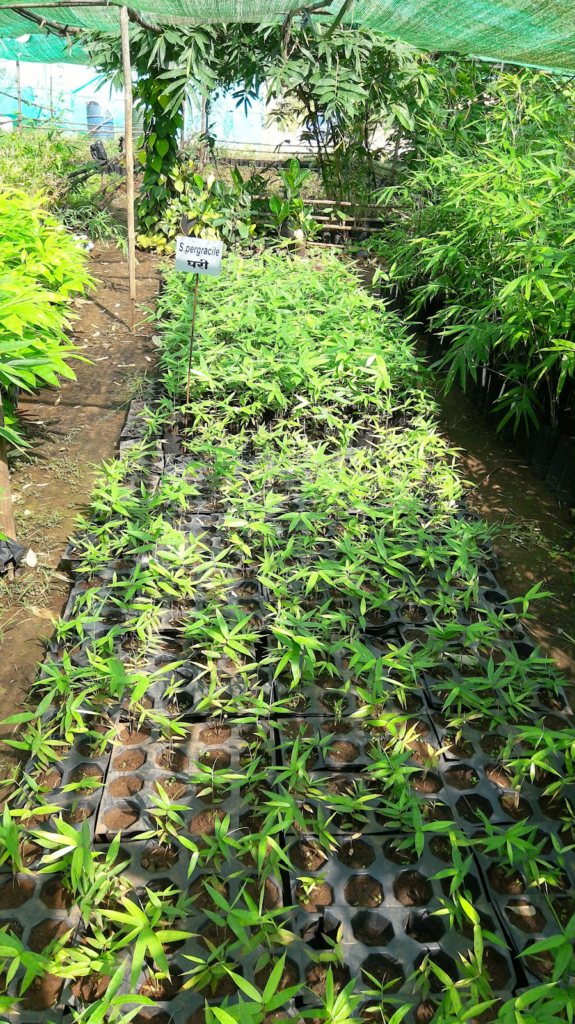
Managing and Harvesting Bamboo
The management of bamboo is an important process that improves the quality and productivity of your bamboo plants. This is particularly true in the case of large-diameter clumping bamboo. This being said, running bamboo may require management to prevent its spread.
While management of an old-established bamboo plant can be pretty laborious, once a plant is tended to, most of the labor is conducted during the harvest. That’s because, by harvesting, you are naturally thinning out clumps and preventing overcrowding caused by an excess of mature canes.
Life Cycle Of Bamboo Canes
Generally speaking, you will have to wait approximately 3-5 years before you harvest your first bamboo canes. In some contexts, this could be longer, and in the case of smaller-diameter bamboo, it could be much sooner.
For cultivation, there are generally four stages of a bamboo cane’s life that you should familiarize yourself with.
- Shoots: These typically occur on a seasonal basis, typically towards the beginning of the rainy season. Shoots can grow extremely quickly, sometimes more than a foot per day. Certain species have edible shoots.
- Immature Canes: These are canes that are less than 3-5 years of age and are not suitable for harvesting because they are still structurally weak and full of sugar. These shoots typically have a bright color and a larger width than more mature canes. They are free of lichens, mosses, and other exterior growths that occur with age. Very young canes have leaf sheaths at the nodes. While these are often the prettiest of the canes, these are not the ones you want to harvest!
- Middle-Aged Canes: These are the canes most desired for construction purposes. These are between 3 and 7 years old, depending on the growing conditions and variety. These have undergone a process known as lignification, which results in stronger and more resistant canes. These shrink in diameter, and the color turns pale or gray. They also have splotches made by lichens and other organisms.
- Mature Canes: These have begun to lose structural integrity due to age. These are very pale, completely covered in splotches, and may even have rust or other pathogenic fungi. These are typically removed during management to open up more space for young shoots.
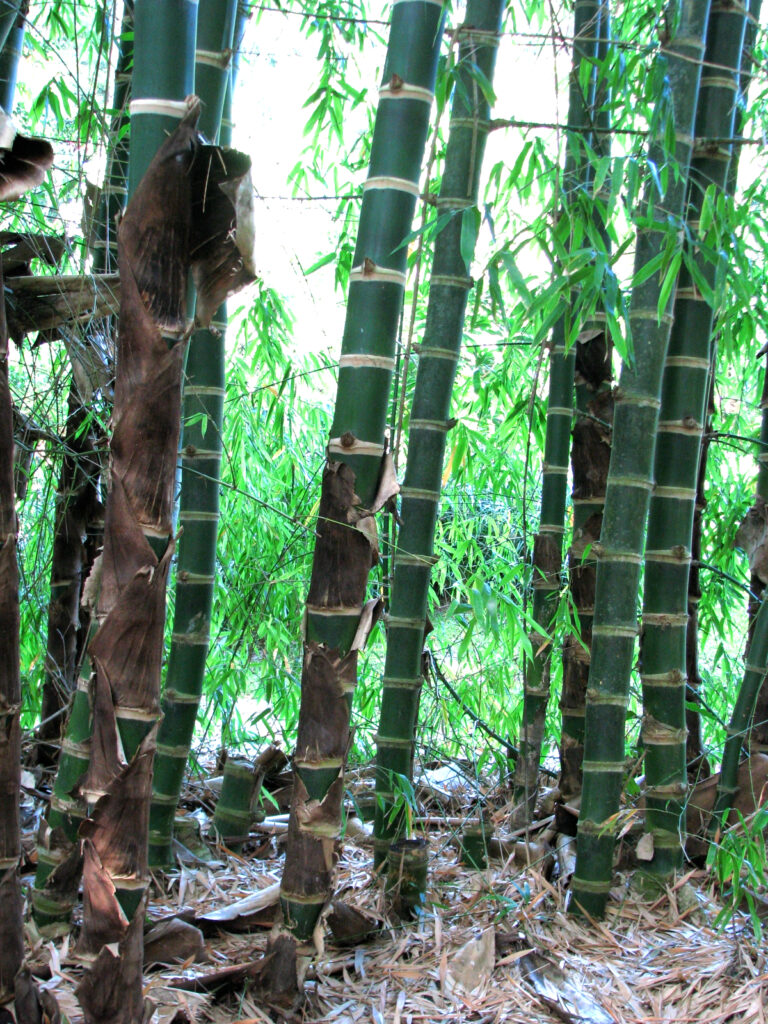
Time Of Year To Work With Bamboo
Bamboo should be managed and harvested at the beginning of the dry season or the very end of the rainy season. There are several reasons for this;
- There is less risk of damaging young shoots that arrive at the beginning of the rainy season.
- Canes harvested this time of year contain fewer starches, which would otherwise impede the durability of the canes.
- Making fresh cuts during the rainy season increases the risk of introducing rot or other pathogens to the clump.
- The dry season is the best time to dry and cure bamboo.
Based on traditional knowledge, it is also recommended to harvest bamboo during the waning moon as it approaches the new moon. This is believed to result in much stronger canes. It is also recommended to harvest canes early in the morning, during or before sunrise.
Management and Harvesting General Considerations
- Making Clean Cuts
When cutting canes, it is important to always leave a clean cut right at the first or second node. Your initial cut can be done where it is most convenient and secure, but make sure to revisit the stump with a sharp saw. Your cut should be done just barely above the node to prevent leaving a “cup” which can collect water and promote rot.
- Sustainable Harvest
It is recommended to never harvest more than 1/3 of all the canes in an already managed clump. The general rule of thumb is to harvest an equal amount of canes to the number of new shoots that arrived during the previous season. - Thinning Old Canes
It is important to remove any old canes that are past their prime. This opens up more room and light for younger shoots to grow. Having an open clump also promotes straighter and stronger canes. For larger clumping bamboo, it is recommended to have only between 12-20 canes at a time.
- Color Coding by Age
To do this, simply paint fresh shoots with a color of your choice. Do this every year, but with a different color to help you keep track of the age. - Controlling the Spread of Running Bamboo
If you want to control the growth of running bamboo, simply harvest the young shoots that appear at the beginning of the growing season. This will typically be in the general vicinity of the plant. It is best to do this just as the first shoots are developing.

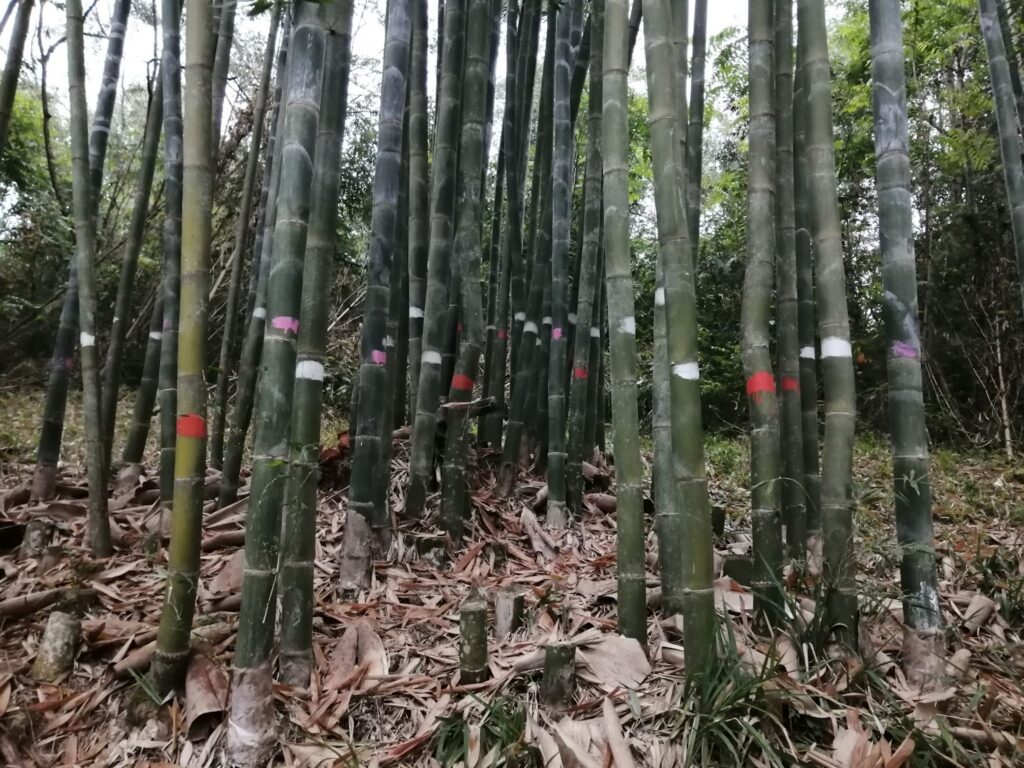


Harvesting Large Diameter Bamboo
As previously mentioned, harvesting large-diameter bamboo is heavy labor. It is on par with cutting down trees and can be equally dangerous if you don’t have the experience. For this reason, use extreme caution and only do this if you are up for the job.
- Identify the middle-aged canes that are best suited for harvesting.
- Once you’ve selected your canes, you’re going to want to begin cutting. You can use a chainsaw or a machete. Handsaws work with smaller bamboos, although they can get stuck with larger bamboos.
- With a machete, the cut comes out less clean, but it can be cleaned up with a saw later. Start cutting the bamboo with a machete at around a sharp 70-degree angle, removing chunks little by little. Circle your cuts around the cane until you’ve almost cut all the way around. At this point, you will want to use a lot of caution. Once you conduct the final cut, the bamboo will “jump” out of place and find its way to the ground near the stump. In most cases, the bamboo cane will be supported by all of the other canes in the clump, so it won’t begin falling horizontally. If you do not have a dense enough clump, use extreme caution.
- With a chainsaw, simply cut the cane horizontally or at a slight angle away from you. If you do a clean horizontal cut, the bamboo will often stay standing on the stump as it is supported by other canes around it. From here, you can push it to the desired side and get it off the stump.
- If you’re in a hurry and durability isn’t a priority, you can begin further processing this bamboo right away. Otherwise, it is recommended to leave the cane standing, placing it on top of a large rock to prevent rot or rooting. This way, the cane will continue using any sugars it has reserved in its tissues for the next 1-2 weeks.
- When you want to bring the bamboo down, you will have to move the bottom end of the bamboo, forcing it to start going more horizontal. Since bamboo is so bushy, you may need to cut some branches and force them through the many branches of the other canes.
- Once horizontal, you can remove branches and cut the cane into pieces of the desired size.
- Make sure to cut the stumps down to the first node. Do this cut with a sharp saw, and make sure to not leave a “cup” which can collect water.
Processing and Treating Bamboo
Before you begin treating bamboo, you will want to clean it up a bit. Using a pressure washer can help remove lichens and any other odd growths present in the canes. Otherwise, a sponge may be your best option. Branches and nodes should be carefully removed to leave a smooth finish. Any rough cuts in the field are also cleaned up at this point. Depending on your treatment method, you may need to use a long iron rod to puncture the nodes on the inside of the bamboo cane. This allows it to be filled with the treatment solution. You can also cut the bamboo into slats before treatment.
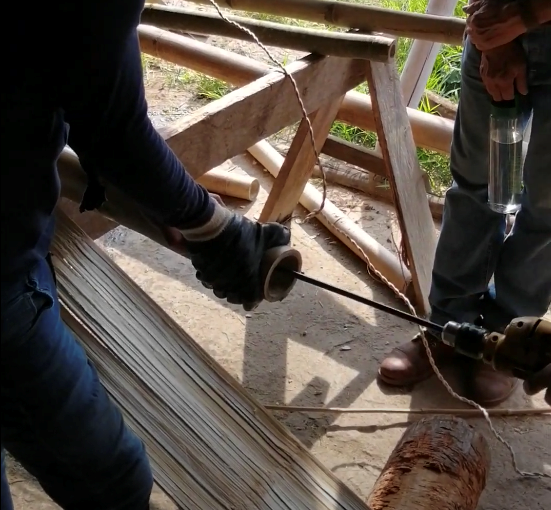
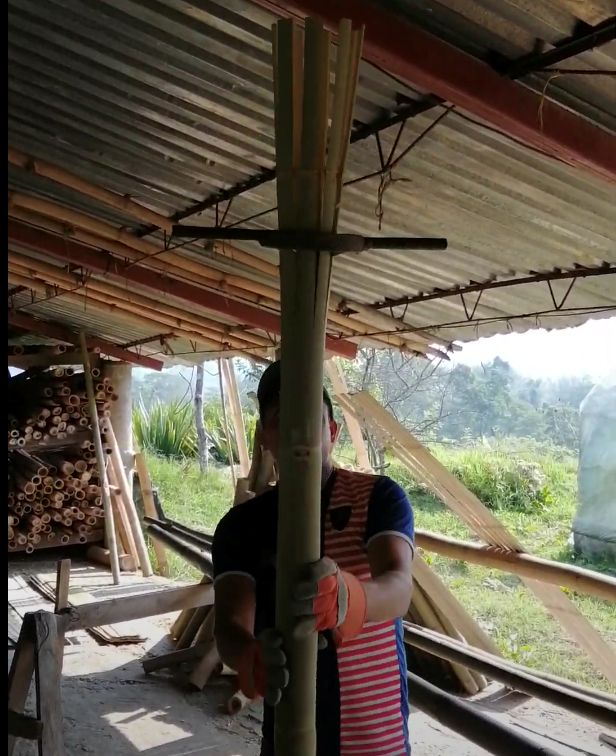
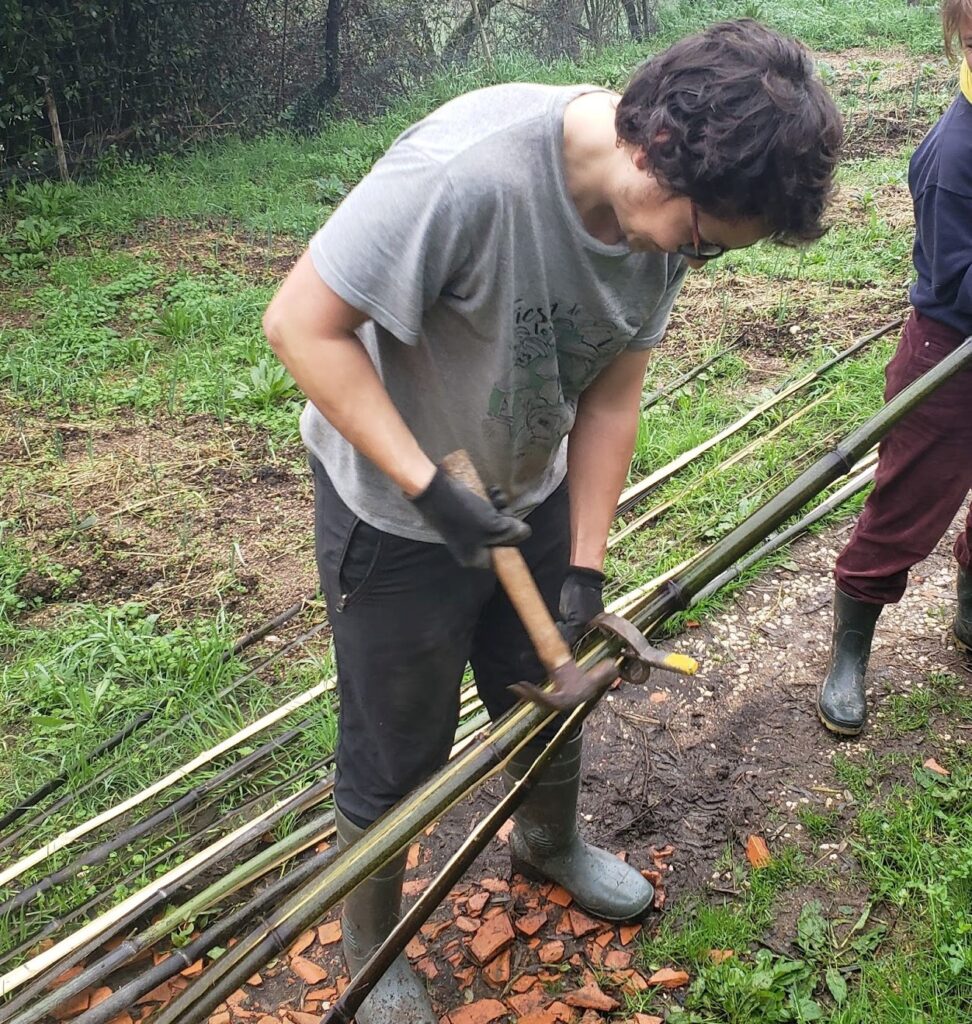
Treating Bamboo
Untreated bamboo can last 2–5 years, depending on its use and the environment it is kept in. Treatment can make bamboo last more than 60 years or longer if done correctly. There are many ways to do this with varying levels of efficiency.
Chemical Treatment with Borax and Boric Acid
Generally speaking, this is the go-to method for long-term preservation that could last over 50 years. Other chemicals can be used for preservation, but these are generally preferred due to their effectiveness and relatively non-toxic properties. There are three main ways chemical treatments are conducted.
- The submersion technique involves submerging the canes in a chemical solution for 1-2 weeks. If you are treating large amounts of bamboo, then you will need a large covered pool for this. If you are treating slats of Bamboo the soak needed is only 5-7 days.
- The boucherie method involves filling the bamboo canes with a chemical solution under pressure. This was traditionally done with gravity pressure but can also easily be done with a specialized pump. Using a pump is excellent because of its speed and effectiveness.
- The vertical soak diffusion method involves puncturing all of the internal nodes of the cane except for one at the bottom. The bamboo is then filled with your treatment solution as if it were a large cup or vessel. This is allowed to soak for 7–14 days before it’s drained and dried.
- While considered less effective than the other techniques, you can also leave the canes standing in a vertical position with the stem butt sitting in a large vessel of your chemical solution. It is often recommended to leave the branches to promote transpiration, which will result in the rise of the chemical solution.
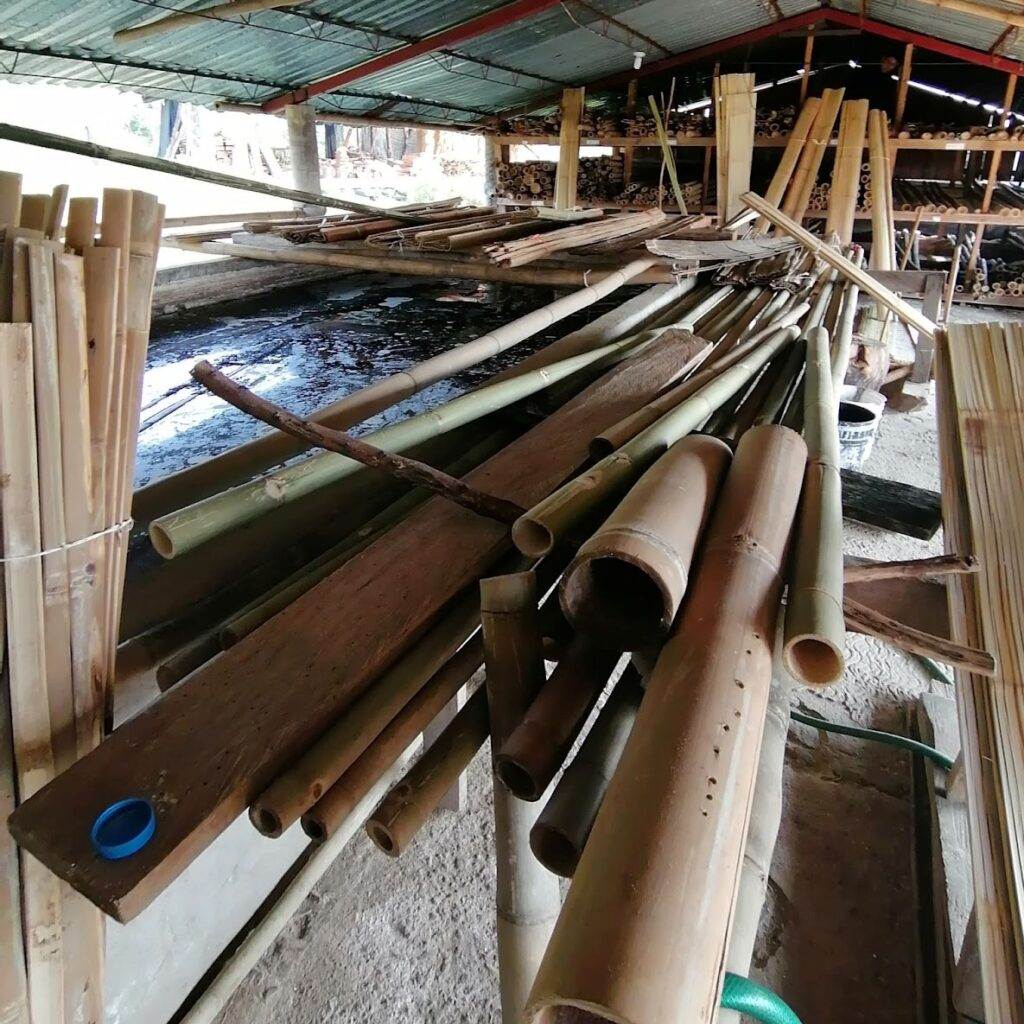
Smoke and Fire Treatment
This traditional method involves heating the bamboo with fire to break down the starches and release the bamboo’s natural oils. It is not considered extremely effective but will improve the lifespan. In addition to this, bamboo can be smoked. These processes require proper monitoring to ensure the bamboo isn’t burned.
Salt-Water Immersion
If you’re lucky enough to live by the ocean, you can try soaking the canes in ocean water. This can be done on land or the nearby shore by securing the canes with anchors. The downside to this is that if you are using metal bits or screws, the salt can cause corrosion. Generally speaking, it is only considered mildly effective. I was living in a project where this technique was conducted, and it does have challenges. One of these was that the canes were filled with sand after the soak and were extremely difficult to transport!
Running Water
You can also leave bamboo soaking in a creek or river. This leeches sugars and nutrients from the canes, thus making them less attractive to fungi and pests. This technique is also only mildly effective.
Final Thoughts on Bamboo Durability
If you’re going to invest in actually building permanent structures with bamboo, then proper treatment is essential. There’s no need to be lazy about this. If you don’t have the proper infrastructure to treat bamboo, you may be able to work with someone in the region who does.
Lastly, it’s important to mention that the conditions in which you use . your bamboo will make all the difference. If you are in a dry climate, this can significantly prolong the durability compared to a humid one. If your cane is not touching the ground and is protected by a roof, it will also last much longer.
Conclusion
While there could easily be a section on how to use bamboo, this is a can of worms I will not open for this text. There are books, websites, blogs, and any form of media you can imagine 100% dedicated to the art of working with bamboo. If you want to build some cool stuff with bamboo, there is no limit to the resources you can find! I’ll leave some images here to help fuel your imagination!

